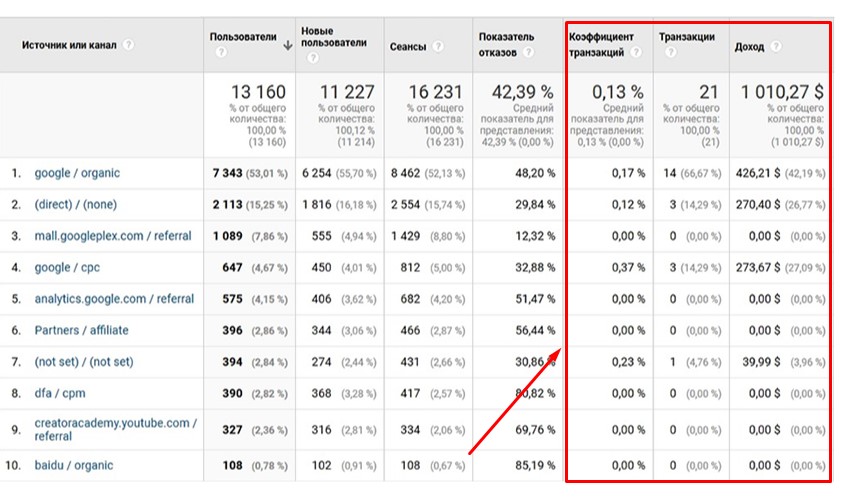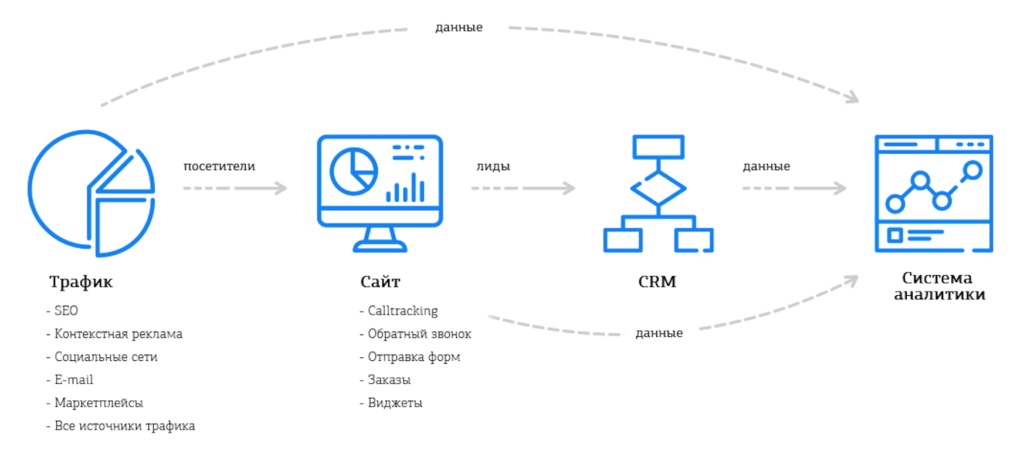Setting up end-to-end analytics

Companies use many tools to attract clients – contextual advertising, social networks, various kinds of mailings, SEO-promotion and much more. At the same time, it is often difficult to understand which of them really work and bring profit, and which ones just lead to waste of budget.
It is to solve this problem that end-to-end analytics exists. It makes it possible to trace the full path of a person from the first contact with an advertisement or website to making a purchase, a request, a call. This way you can see what role each marketing tool plays at different stages of the sales funnel.
For example, it may turn out that social networks are good at attracting people to the site, but there are few conversions from them. On the contrary, e-newsletters to the base, on the contrary, lead to a large number of orders. Or it turns out that the small traffic channel you wanted to disable actually brings a lot of hits.
By setting up end-to-end analytics, you can finally optimize your budget and allocate funds where they bring the maximum return. The advertiser will know exactly which channels can be abandoned without damaging the business, and which, on the contrary, need to be scaled up.
How many calls and sales will I get by ordering contextual advertising from you?
I need to calculate the conversion of my website
Describe
the task
in the application
Calculate potential ad revenue
Google
contextual advertising calculator
What is end-to-end analytics?
End-to-end analytics is a powerful tool that allows you to get a complete picture of how your target audience interacts with your business. It combines data from various sources – advertising offices, online analytics services, CRM systems, ERP into a single database.
The main purpose of such analytics is to help marketers and company managers make informed decisions to optimize campaigns, improve customer interaction and increase business performance. It helps answer key questions:
- Which campaigns generate the highest return on investment?
- Which stages of the funnel lose the most customers?
- What is the cost of engagement (CAC) for each channel?
- What user actions on the site correlate with purchases?
- How to increase conversion and average check?
Across-the-board analytics tracks a person’s full path from first contact to purchase and beyond, collecting information on all points of interaction – clicks, site visits, content interaction, completed forms, and so on. It also takes into account financial metrics – CAC, LTV, ROI and others.
What tasks will end-to-end analytics help accomplish?
Turnkey end-to-end analytics setup service helps businesses solve a number of key tasks:
- Track the full customer journey – from the first interaction to making a purchase. In this way, you can understand which tools are most effective in attracting audiences and converting them into buyers.
- Receive statistics in real time. This makes it possible to quickly react to any changes and promptly make informed decisions on optimizing advertising campaigns.
- Automate campaign management. By analyzing the quality of different channels, you can allocate your budget more intelligently, avoid inefficient spending and get the maximum return on your promotion investments. End-to-end analytics greatly simplifies bid management for individual campaigns, which helps to increase their profitability.
- Segment audiences into groups. Separate segments can be distinguished based on behavior on the site, demographic attributes, sources of transition, etc. This helps to personalize the communication process, prepare individual offers for each group, perform presales, and extend the customer lifecycle.
- Connect ROPO analysis. It allows you to evaluate how online activity (site visits, online brand interaction, etc.) affects offline sales in physical locations.
- Conduct A/B testing. Comparing different variants of ads, landing pages and other elements allows you to identify the most effective approaches and scale them.
How does end-to-end analytics differ from setting goals in Google Anlytics?

The main differences between setting up end-to-end analytics in Google Analytics and standard goal setting are:
- Identification of selling traffic channels – Google Analytics automatically assigns the transaction to the channel with which the user interacted last (e.g., when the user first came to the site from PPC and then from search, and only then made a purchase, the transaction will be recorded from the “Free Search Traffic” channel, which is not quite correct);
- In the standard setting of goals only completed transactions are accounted for – Google Analytics takes into account only the requests left on the site, and not the fact of a real sale (for example, you have launched targeted advertising on Facebook and product ads in Google – the first campaign received 100 requests, the second 50. At first glance Facebook worked better, but in fact closed transactions in the first case were 10, and in the second – 40, which allows you to draw conclusions and more effectively spend the budget);
- The ability to see the sum of expenses for each advertising channel – it may turn out that the channel that brings the largest number of sales is the most expensive and in the end – unprofitable, and the channels that bring fewer transactions – the most profitable for the company, but with them marketers work little and not so effectively. You can find this out by setting up end-to-end analytics. If you set up only the goals yourself, you will see the number of requests from each channel without detailing the expenses for it and without understanding whether an order has been received and for what amount from this request.
What are the advantages of installing end-to-end analytics?
- It helps to optimize the budget. It becomes possible to redistribute costs in favor of more effective promotion methods and disable or optimize those that do not bring the desired return. As a result, the budget is spent more rationally, and the performance of campaigns increases.
- Allows for a more comprehensive assessment of the effect of advertising. Thanks to end-to-end analytics, you can track the entire customer journey – from clicking on an ad to making a purchase. This allows you to analyze key metrics along the funnel – conversion of visitors to leads and buyers, cost per lead and sale, revenue, and more.
- Simplifies analytics. Due to the fact that information is collected automatically from CRM, marketing platforms, web analytics systems, advertisers are freed from the routine work of collecting and summarizing data. With all information in one place, you can quickly evaluate ROI, CAC and other metrics.
- Makes it easier to prepare reports. You can always quickly access and upload the information you need. Typical reports for management can be set up once, and then simply upload relevant information for the required period (week, month, quarter).
- Provides transparency in the work of advertising and sales departments. Marketers can see how many leads and sales each advertising campaign generates. Managers, in turn, can evaluate the conversion of leads into customers.
What steps are involved in setting up end-to-end analytics?
If you order turnkey setup of end-to-end analytics, the process will include several stages:
- Audit of existing systems. At this stage, we meet with all stakeholders to identify the key metrics and reports that should be displayed on the final dashboards. We use the most appropriate metrics at each stage of the user’s interaction with the ad. For example, CTR and the number of clicks during customer acquisition, the value of purchases at conversions, ROI when evaluating overall campaign performance. This allows you to optimize the campaign across the entire funnel.
- Preparation of technical specifications. We select tools to implement the analytical solution, create a data schema, and approve the design of dashboards. All services used should be integrated into a single system.
- Set up data collection and aggregation. Optimize UTM tags to get detailed information for each channel. Create connectors for data upload. The analytical solution is deployed in the cloud. Raw data from different sources is combined, aggregated and summarized into final reports. Connect visualization tools to create dashboards.
- Analyze the collected metrics. Based on data from call tracking systems, web analytics, UTM tags and other sources, we evaluate user interaction with advertising at different stages. This way we can identify the strengths and weaknesses of the current strategy.
- Maintaining the implemented solution. This includes updating connectors when data structures change, adding new sources and reports as needed. Here, it is important to ensure stable operation of the entire system on an ongoing basis.
What does the end-to-end analytics customization service include?

The end-to-end analytics customization service includes:
- End-to-end web analytics implementation – allows you to track critical KPI changes in Google Analytics and Google Tag Manager;
- Offline advertising effectiveness evaluation – allows you to evaluate the effectiveness of introducing promo codes, coupons, promotions offline by tracking phone calls via IP-telephony;
- Call tracking – allows you to transmit information about the source from which each caller came to the site (it is assigned a serial number, which is fed into the company’s analytics and CRM systems).
- Online interaction tools – tracking and recording of requests that came from online chat, callback services on the site;
- CRM-system – a platform that allows you to organize your business (record requests, maintain information on each client, income and advertising costs).
The price of setting up end-to-end analytics depends on the number of implemented tracking systems, the cost of the programmer’s work and the complexity of the sales funnel. On average, the approximate cost will be from $300.
As a rule, when setting up end-to-end web analytics, we recommend combining it with setting up convenient Data Studio reporting from Google.
When you may need a service for implementing end-to-end analytics?
Implementing end-to-end analytics may be required when a business needs to get a complete and accurate picture on the performance of marketing campaigns. Here are the main situations where it makes sense to think about customization:
- If you use multiple advertising platforms (Google Ads, Facebook Ads, TikTok Ads, etc.), web analytics systems (Google Analytics, Microsoft Clarity), CRM systems and other tools, bringing all the information together without end-to-end analytics can be time-consuming.
- End-to-end approach is indispensable for businesses that combine online and offline sales. With the help of this tool, you can track the customer journey and evaluate the contribution of each channel (website, mobile app, offline sales outlets) to the overall result.
- In a situation where third-party specialists are in charge of setting up campaigns, end-to-end analytics will help control the quality of their work. The customer will see an objective picture, rather than relying on the contractor’s reports.
- If the audience makes purchases not only on the website, but also on the phone or in chats, Bi analytics will help to account for these communications and correctly evaluate them.
- When a company has a dedicated marketing department, it is vital for it to see an objective picture of all customer communications and accurately assess how any activity affects sales.
- When launching a startup, it’s critical to thoroughly analyze all metrics and quickly adjust your approach based on the insights you receive.
Popular questions
- Setting up end-to-end analytics allows you to determine the ROI (return on investment) of your advertising. This tool allows you to track the entire user journey from the first touch with the site to the order.
- If only one advertising channel is used, Google Analytics will suffice. If the site has contextual advertising, contextual media network, Facebook advertising, and organic traffic from search, then you can’t do without end-to-end analytics. The main difference of end-to-end analytics is the ability to track the effectiveness of each advertising channel.
- Analytics gives access to all information on the number of orders on the site, items that have been ordered, their cost. Not only orders are recorded, but also real sales, calls and online chat requests. All data is displayed in the CRM system.
- It depends on how well established the business processes are in the company, what CRM system it works with, whether Call Tracking is connected, whether UTM tags are used for different traffic channels. In general, the process takes 1-3 months.

